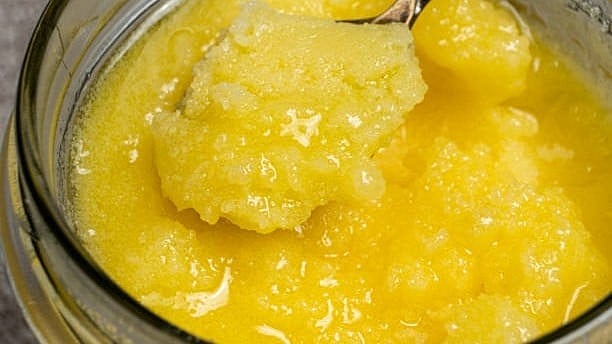
Image showing ghee. (For representation)
Credit: iStock Photo
Recently, the Central Crime Branch Special Investigation Squad busted an interstate racket of adulterated ghee sold with fake Nandini packaging in Bengaluru. The seized goods were valued at Rs 1.26 crore. According to officials, the ghee was manufactured in Tamil Nadu by mixing coconut oil and palm oil with ghee.
Metrolife spoke to experts about how one can identify pure ghee.
“Pure cow ghee has a rich, nutty aroma that lingers. If it fades quickly or smells oily, it’s likely adulterated,” says Listy Prabhakar, co-owner of
a ghee brand. Cow ghee’s natural yellow colour comes from beta-carotene, a pigment in cow’s milk. “If it’s pale yellow or white, be cautious. But buffalo ghee is usually white,” she adds.
Ramaprasad T R, senior principal scientist at the Central Food Technological Research Institute (CFTRI), points out that most ghee adulteration is “almost impossible to detect without advanced laboratory equipment”.
Ramaprasad, who specialises in lipids and ghee, explains that ghee varies widely across regions. “The flavour and aroma heavily depends on what the cows or buffaloes are fed,” he says.
Kitchen tests
Shalini Arya, professor of food technology at the Institute of Chemical Technology, says consumers can do a few tests at home to identify ghee’s purity.
“Ghee includes saturated and unsaturated fatty acids. If you take a small teaspoon of ghee and refrigerate it for a couple of hours, pure ghee will develop a uniform, grainy, crystalline texture,” she explains. This graininess comes from the way saturated fatty acids solidify into crystals.
Most adulteration, she says, happens through palm oil as it has no strong flavour and blends easily. “But it will not form that uniform grainy texture. You will see clear separation between the liquid and solid parts,” she says.
Another test is a palm test: When you spread pure ghee across the palm, the graininess remains perceptible. With adulterated versions, especially those containing palm oil, the texture feels greasy and sticky, she adds.
Other oils, including sunflower oil, are also sometimes used to adulterate ghee. “If sunflower oil or dalda is mixed, the butyric acid which gives ghee its aroma and flavour gets diluted — its smell will be faint and flavour muted,” she says.
KMF says...
B Shivaswamy, managing director of Karnataka Milk Federation (KMF), says Nandini’s ghee “has a distinct aroma”. He adds that a special committee is reviewing how to “make the artwork on the ghee packets difficult to copy”. “We are contemplating introducing individual QR codes, but it will be costly,” he adds.